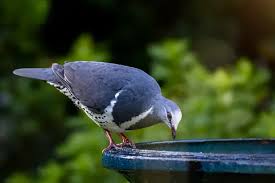ANIMAL: Wonga Pigeon Leucosarcia melanoleuca Type of Animal: Pigeon/Dove Habitat: Coastal forest, rainforest, scrub, picnic areas, walking tracks, carparks, roadsides, gardens, wet eucalypt forest, clearings, wet forested gullies, riparian areas, along tracks, subtropical/tropical dry shrubland Location(s): E Australia Appearance: Large plump pigeon w/ short neck, broad wings, long tail, pastel blue-grey to steel-grey back feathers w/ creamy white head & white underside w/ dotted dark gray spots, deep pink to red legs/feet. Younger birds more brown. Food/Diet: Seeds, fruit, berries, insects, insect larvae, worms, snails Status in Wild: Stable Conservation: Breeding in zoos & wildlife centers Lifestyle: Monogamous pairs or small flocks of 2-8 birds Additional Info: Called: Male: Cock Female: Hen Young: Squab Group: Flock Weight: 11.64-17.63 oz Gestation: 3.5 weeks Life Span: 12-16 years Height: 1.26-1.3 ft Body Length: 1.26-1.3 ft Tail Length: 1.3 in Main predators are cats, canids, raptors, snakes, & monitor lizards. Sometimes persecuted as crop pests. Used to be hunted for meat & sport. These birds forage on the ground. Call is loud, high-pitched ‘coo.’ Breed between October & January. Nest is saucer-shaped twig/stick platform w/ 11.8 in diameter & built 9.84-65.61 ft above ground. Sometimes use abandoned nests from topknot pigeons or tawny frogmouths. Breeding pairs usually lay 2 eggs. Produce explosive wing claps when disturbed. Males bow during courtship. Feeds most often in early morning & late afternoon. Bowing & clicking are common threat displays. Sometimes, they’ll charge. When sitting on nest, they use ‘cryptic posture’, w/ tail raised high & facing observers. Sometimes, these birds will play dead to deter intruders away from nest. Fun Fact(s): Like most pigeons/doves but unlike most birds, drink by sucking up water into bills rather than scooping up water & tilting heads back. Pigeons, along w/ flamingos only birds to produce “crop milk”, which is secretion produced by both sexes to form diet of nestlings for 1st few days. Loud ‘woop woop’ calls can be heard from more than a mile away. These birds are secretive, more often heard than seen. They’re less shy when used to humans. They often follow exact same path each time they visit feeding site. Also called Wonga Wonga.
